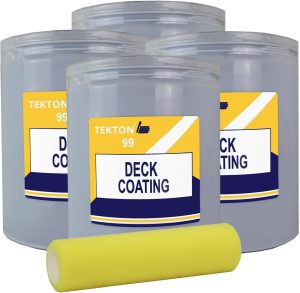A deck is a significant investment in your home, providing a space for relaxation, entertainment, and enjoying the outdoors. But just like any other part of your house, it requires maintenance to keep it looking its best and ensure its longevity. One of the most important aspects of deck care is painting or staining. Not only does a fresh coat of paint protect the wood from the elements, but it also enhances the overall aesthetic appeal of your outdoor space.
When it comes to painting a deck, timing is everything. If you paint your deck at the wrong time, you might not achieve the best results, or worse, the paint might peel and fade prematurely. To help you navigate the best time to paint a deck, we’ve put together a comprehensive guide that will answer all your questions, provide valuable tips, and set you up for success. Plus, we’ll address some frequently asked questions to clear up any confusion about deck painting.
Why Timing Matters When Painting a Deck
The best time to paint a deck is influenced by a few factors, such as the weather, temperature, and humidity. These elements can significantly affect how well the paint adheres to the surface, how it dries, and how long it lasts. If the weather is too hot, cold, wet, or humid, you might face issues with uneven application, peeling, or bubbling, which can cause frustration and extra work.
Choosing the right time to paint a deck is essential for the following reasons:
- Adhesion: Paint needs a clean, dry surface to adhere to properly. If the deck is too wet, or if it’s too hot or humid, the paint may not bond well to the wood.
- Drying Time: Temperature and humidity directly impact drying time. If it’s too cold, the paint will take much longer to dry and cure. Too hot, and the paint might dry too quickly, leading to streaks and uneven coverage.
- Longevity of the Finish: Painting at the optimal time ensures that your deck’s finish lasts longer, making your investment worthwhile.
Understanding the ideal conditions and timing for painting a deck can save you time, effort, and money in the long run.
The Best Time of Year to Paint a Deck

Generally, the best time of year to paint a deck is during spring or early fall, but the exact timing depends on the climate of your area. Let’s break down the ideal seasons for deck painting:
1. Spring (March to May)
Spring is often considered one of the best times to paint a deck, as it provides moderate temperatures, which are perfect for ensuring the paint adheres well and dries properly. As long as you avoid the early spring rains, the dry days of spring can offer ideal conditions for painting.
- Advantages:
- Temperatures are mild, usually between 50°F and 85°F (10°C to 29°C), which is the optimal range for paint to dry and cure.
- Dry days are common, giving your deck plenty of time to dry between coats.
- Spring is a great time to clean and prep your deck after winter before applying paint.
- Considerations:
- Watch out for late-season rains or humidity, as excessive moisture can affect the paint’s drying and bonding.
2. Early Fall (September to October)
Early fall is another excellent time to paint your deck. During this season, temperatures tend to be more stable, and the humidity is lower than in summer, making it easier for the paint to dry and cure properly.
- Advantages:
- Temperatures remain warm enough for the paint to dry effectively without being too hot.
- Humidity is usually lower, which helps prevent issues with bubbles or streaks.
- The wood has had a chance to dry out from the summer, so it’s easier to clean and prep the deck.
- Considerations:
- Be mindful of early cold snaps, as temperatures should stay above 50°F (10°C) for at least 48 hours after painting to allow for proper drying.
3. Summer (June to August)
While summer might seem like an obvious choice, it’s actually a less favorable time to paint a deck, especially in regions with extremely hot weather. High temperatures can cause the paint to dry too quickly, leading to issues like streaking, lap marks, and uneven coverage. That said, if you live in a cooler region, summer could still work, but it’s important to avoid painting during the hottest parts of the day.
- Advantages:
- Long days mean you have more hours to work on your deck.
- If you live in a cooler climate, summer might be a good option for painting, as the temperatures are warmer than spring or fall.
- Considerations:
- Extremely hot temperatures can make it difficult for the paint to settle properly.
- Direct sunlight can lead to uneven drying, especially if the deck is exposed to harsh sunlight for long periods.
- Humidity might still be high in some areas, which can cause issues with drying time.

4. Winter (November to February)
Winter is typically not a good time to paint a deck, particularly in areas where temperatures dip below freezing. In cold weather, the paint can freeze, which will ruin its ability to bond to the wood and affect its durability. If you live in a more temperate climate where winter temperatures stay above 50°F (10°C), it might be possible to paint your deck during this time, but it’s still a risky choice.
- Advantages:
- There’s less chance of rain or snow, so the deck will remain dry.
- You may find fewer scheduling conflicts with contractors if you’re hiring a professional to paint your deck.
- Considerations:
- Freezing temperatures can prevent paint from properly adhering to the wood.
- Drying times are extended in cold conditions, so the paint might take much longer to dry and cure.
Key Factors to Consider When Painting Your Deck
While timing plays an important role, there are additional factors that will help you achieve the best possible results when painting your deck. These include:
1. Weather Conditions
- Temperature: Paint typically dries best when the temperature is between 50°F and 85°F (10°C and 29°C). Avoid painting in extreme heat or cold to prevent the paint from drying too quickly or not drying at all.
- Humidity: High humidity can cause paint to take longer to dry, which can lead to issues such as bubbling or streaking. Try to paint when the humidity level is relatively low (below 70%).
- Rain: Always check the weather forecast for the next few days before starting a painting project. If it’s expected to rain within 24 to 48 hours, it’s best to wait until the forecast is clear.
2. Deck Preparation
Preparing your deck is just as important as choosing the right paint and timing. Before applying a fresh coat of paint, make sure to clean your deck thoroughly. This includes power washing, removing any dirt, debris, and mold, and allowing the deck to dry completely.
If the deck has been previously stained or painted, you may need to sand or strip the old finish to ensure the new paint adheres properly.
3. Paint Type
The type of paint or stain you choose will affect how it performs in different weather conditions. High-quality deck paints and stains are designed to withstand the elements, and many are specifically formulated for exterior use, offering protection against UV rays, rain, and moisture.
- Acrylic Deck Paint: Acrylic paints are popular because they are durable, fade-resistant, and quick-drying. They also provide good coverage, making them a great choice for deck painting.
- Oil-Based Stains: Oil-based stains penetrate deeper into the wood, providing long-lasting protection against the elements. However, they may take longer to dry compared to acrylic paints.
4. Proper Drying Time
After painting, make sure your deck has ample time to dry. The drying time varies depending on the type of paint or stain you used, the weather conditions, and the thickness of the application. Be patient and avoid walking on the deck until it has fully dried to prevent marks or damage.
7 Frequently Asked Questions About Deck Painting
- Can I paint my deck in the winter? It’s not recommended to paint your deck in the winter, especially if temperatures fall below 50°F (10°C). Cold temperatures can interfere with the paint’s ability to bond and dry properly.
- Can I paint my deck in direct sunlight? It’s best to avoid painting your deck in direct sunlight, as the paint can dry too quickly, leading to streaks and uneven coverage. Choose a cooler time of day when the sun is not directly on the deck.
- How do I know when my deck is ready to be painted? Before painting, ensure that the deck is clean, dry, and free from debris. If your deck has been exposed to moisture, give it ample time (at least 48 hours) to dry completely before applying paint.
- How long does it take for deck paint to dry? Deck paint typically takes between 4 to 6 hours to dry to the touch, but it’s best to wait 24 to 48 hours before applying a second coat, and 72 hours before walking on the deck.
- How long will deck paint last? High-quality deck paint can last between 3 to 5 years, depending on the climate, the quality of the paint, and the amount of foot traffic on the deck.
- Can I use any type of paint for my deck? It’s important to use exterior-grade paint or deck stain specifically designed for wood. Using regular interior paint won’t provide the protection your deck needs against the elements.
- What if it rains after I’ve painted my deck? If it rains before the paint has fully dried, it can cause the paint to bubble or streak. If this happens, you may need to do some touch-ups after the deck has dried completely.
Conclusion
The best time to paint a deck is when the weather is mild, dry, and not too humid—typically in the spring or early fall. Avoid painting during extreme weather conditions like intense heat or cold, as these can interfere with the paint’s ability to adhere and dry properly. By considering the weather, preparing your deck, and choosing the right paint, you can ensure that your deck looks great and lasts for years to come.
With proper timing and care, you’ll have a beautiful deck that is ready to impress your guests and provide a welcoming outdoor space for many seasons.


Leave a Reply